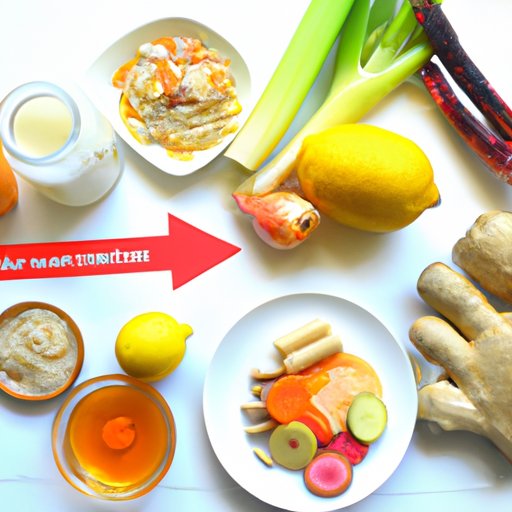Introduction
Acid reflux is a common digestive disorder that occurs when stomach acid flows back up into the esophagus. It can cause heartburn, chest pain, difficulty swallowing, and a sore throat. While certain medications can provide relief, making dietary and lifestyle changes can also help reduce symptoms. In this article, we’ll explore what to eat with acid reflux and discuss some home remedies for symptom relief.

Creating a Low Acid Diet Plan for Acid Reflux
If you’re living with acid reflux, it’s important to know which foods may be triggering your symptoms. Common culprits include fried and fatty foods, spicy foods, citrus fruits, garlic, onions, tomatoes, and caffeinated beverages. Keeping a food diary can help you identify which foods are causing your symptoms. Once you’ve identified your triggers, you can make adjustments to your diet plan.
In addition to avoiding trigger foods, understanding portion sizes and meal timing can also help. Eating larger meals can put pressure on the lower esophageal sphincter (LES), which can lead to acid reflux. Eating smaller meals throughout the day can help reduce pressure on the LES. Waiting at least three hours after eating before lying down can also help prevent symptoms from occurring.
Exploring Foods that Help Reduce Acid Reflux Symptoms
Incorporating certain foods into your diet can help reduce acid reflux symptoms. High-fiber foods like oatmeal, apples, and bananas can help absorb stomach acid and reduce symptoms. Lean protein sources such as poultry, fish, and tofu can also help keep symptoms at bay. Healthy fats like nuts, seeds, avocados, and olive oil can be beneficial as well. Complex carbohydrates such as quinoa, brown rice, and whole wheat bread can also help reduce symptoms.
Home Remedies to Soothe Acid Reflux
In addition to diet changes, there are several natural remedies that can help reduce symptoms of acid reflux. Herbal teas like ginger, chamomile, and licorice root tea can help soothe the digestive tract. Adding a teaspoon of apple cider vinegar to a glass of water can also help reduce symptoms. Baking soda can also be used to neutralize stomach acid. Finally, consuming ginger in the form of tea, capsules, or fresh slices can help reduce symptoms.
How to Make Acid-Friendly Meals
When creating meals, it’s important to avoid foods that can aggravate acid reflux symptoms. This includes spicy, fried, and acidic foods. Instead, opt for foods that are low in fat, high in fiber, and easy to digest. Adding herbs and spices to meals can help boost flavor while keeping the meal low in fat and acid. Low-fat dairy products such as yogurt and milk can also be beneficial. Drinking plenty of water throughout the day can also help reduce symptoms.

Benefits of Eating Alkaline Foods with Acid Reflux
Eating an alkaline diet can help reduce symptoms of acid reflux. According to a study published in the Journal of Environmental and Public Health, “alkaline foods may reduce the frequency and severity of reflux symptoms.” Increasing consumption of fruits and vegetables, reducing consumption of processed foods, and replacing refined grains with whole grains can all help create an alkaline diet.

Making Healthy Food Swaps for Acid Reflux
Making healthy food swaps can also help reduce symptoms of acid reflux. Substituting high-acid ingredients with low-acid options can help reduce symptoms. For example, swapping out tomato sauce for pesto or using almond milk instead of cow’s milk. Choosing healthier cooking methods such as steaming, baking, and grilling can also help reduce symptoms. Lastly, eating smaller portions can help reduce pressure on the LES.
Understanding the Role of Probiotics in Acid Reflux Management
Recent research has suggested that probiotics may help reduce symptoms of acid reflux. A review published in the journal Nutrients found that probiotics may help reduce symptoms of GERD by increasing beneficial bacteria in the gut. Different types of probiotics include lactobacillus, bifidobacterium, and saccharomyces boulardii. Potential benefits of probiotics include improved digestion, reduced inflammation, and increased immunity.
Conclusion
Acid reflux is a common digestive disorder that can cause uncomfortable symptoms. Making dietary and lifestyle changes can help reduce symptoms of acid reflux. Identifying trigger foods, incorporating low-acid options, and exploring home remedies can all help reduce symptoms. Additionally, understanding the role of probiotics in acid reflux management can help establish a long-term plan for symptom relief. Following these tips can help you find relief from acid reflux.
(Note: Is this article not meeting your expectations? Do you have knowledge or insights to share? Unlock new opportunities and expand your reach by joining our authors team. Click Registration to join us and share your expertise with our readers.)
